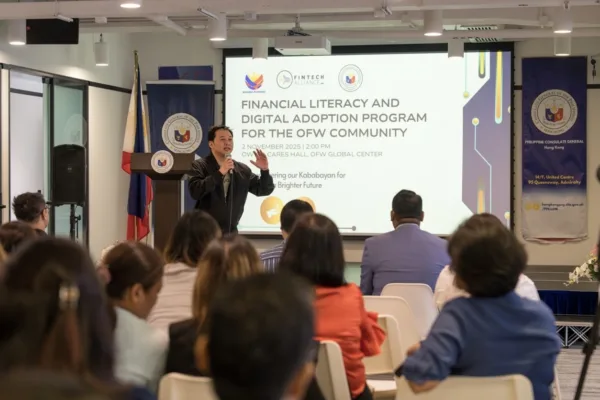by Alexis Tuble, Correspondent
The Philippine digital lending market is rapidly expanding, driven by a surge in app usage and demand for accessible credit — particularly among the Gen Z population.
As the market grows, regulators are responding with tighter rules to protect consumers and ensure sustainable practices.

The digital lending industry in the Philippines continues to gain momentum, with projections indicating it will surpass the US$1 billion mark in 2025.
According to a market study by Digido, the sector expanded from US$693 million in 2023 to US$796 million in 2024, driven by increasing demand for fast, convenient borrowing solutions. Non-bank digital lenders currently dominate the market, capturing 55% of the total share, while digital banks hold the remaining 45%.
Digital lending accelerates
This growth is further reflected in the sharp rise in mobile app activity. Lending app downloads soared by 56% year-on-year, reaching nearly 58.9 million installations in 2024. The surge underscores Filipinos’ growing preference for more flexible and accessible financial tools, particularly as more consumers turn to mobile platforms for short-term credit. These trends point to a rapidly evolving financial landscape where digital borrowing is becoming a mainstream option across demographics.
Regulators respond with crackdowns
As digital lending accelerates in the Philippines, regulators are cracking down on abusive and unregulated practices. The Securities and Exchange Commission (SEC) continues to enforce a moratorium on new online lending licenses, aiming to stop the spread of predatory lenders and strengthen oversight of digital financial players.
This decisive action reflects the government’s push to protect borrowers and uphold ethical lending standards.
The SEC now requires lending firms to fully comply with the Lending Company Regulation Act, which mandates a minimum paid-up capital of ₱1 million, according to legal advisory firm Respicio & Co. Regulators are also pushing companies to meet strict requirements under the Data Privacy Act of 2012, including adherence to cybersecurity, data protection, and anti-money laundering (AML) protocols.
The Bangko Sentral ng Pilipinas (BSP) and the National Privacy Commission (NPC) actively supervise these obligations to ensure lenders operate transparently and responsibly. Through these crackdowns, authorities are taking a more aggressive stance to clean up the digital lending ecosystem and protect consumers from financial harm.
Regulators push for consumer protection

The BSP is intensifying its efforts to ensure that digital lending innovation aligns with strong consumer protection standards. BSP Deputy Governor Chuchi Fonacier emphasized that financial technology must prioritize borrowers’ safety and well-being — not just convenience and growth.
Fonacier reiterated the BSP’s call for transparent and fair lending policies, the establishment of robust governance frameworks, and the use of accurate credit assessments to curb predatory lending and prevent risky practices like loan stacking. These measures aim to promote responsible lending and safeguard borrowers from exploitation.
The BSP actively monitors digital lending institutions to ensure compliance with ethical lending practices. It keeps a close eye on areas such as interest rate capping, responsible debt collection, and the fair treatment of clients. By holding digital lenders accountable, the BSP reinforces its commitment to creating a more inclusive and secure financial system.
While the BSP pushes for these consumer protections, digital banks also grapple with the challenge of balancing these stringent new requirements with their own profitability goals.
Risk of over-indebtedness still looms
While digital loans have significantly expanded financial access, particularly for underserved and unbanked Filipinos, experts caution that the rapid growth of this sector may come with unintended consequences.
According to a study by the University of the Philippines School of Economics, the ease of securing instant online credit — often requiring only minimal documentation—can lead to a false sense of financial capacity, especially among young earners and low-income borrowers.

This convenience, combined with aggressive in-app marketing and short repayment terms, is contributing to a growing risk of over-indebtedness. Borrowers who rely on multiple digital lenders may find themselves trapped in a cycle of re-borrowing just to stay afloat, which could eventually undermine their financial stability.
Financial analysts emphasize the urgent need for comprehensive borrower education, stricter creditworthiness assessments, and industry-wide ethical standards to prevent digital loans from evolving into modern debt traps.
Inclusion vs. Regulation – Striking the right balance

The rapid rise of digital lending in the Philippines underscores a very real demand for accessible, fast, and flexible financing — especially among the youth, gig workers, and unbanked populations. However, this progress comes with systemic risks, including over-indebtedness, weak credit assessments, and predatory practices that could erode public trust.
As key regulators like the BSP and the Securities and Exchange Commission (SEC) strengthen oversight and introduce critical safeguards, the path forward for fintech in the country will require a careful balance: financial inclusion must go hand-in-hand with consumer protection, and innovation must be tempered by accountability.
To ensure long-term, sustainable growth, stakeholders—digital banks, fintech firms, investors, and policymakers — must invest not just in advanced technologies, but in building trust, transparency, and ethical lending frameworks that truly serve the Filipino people.








